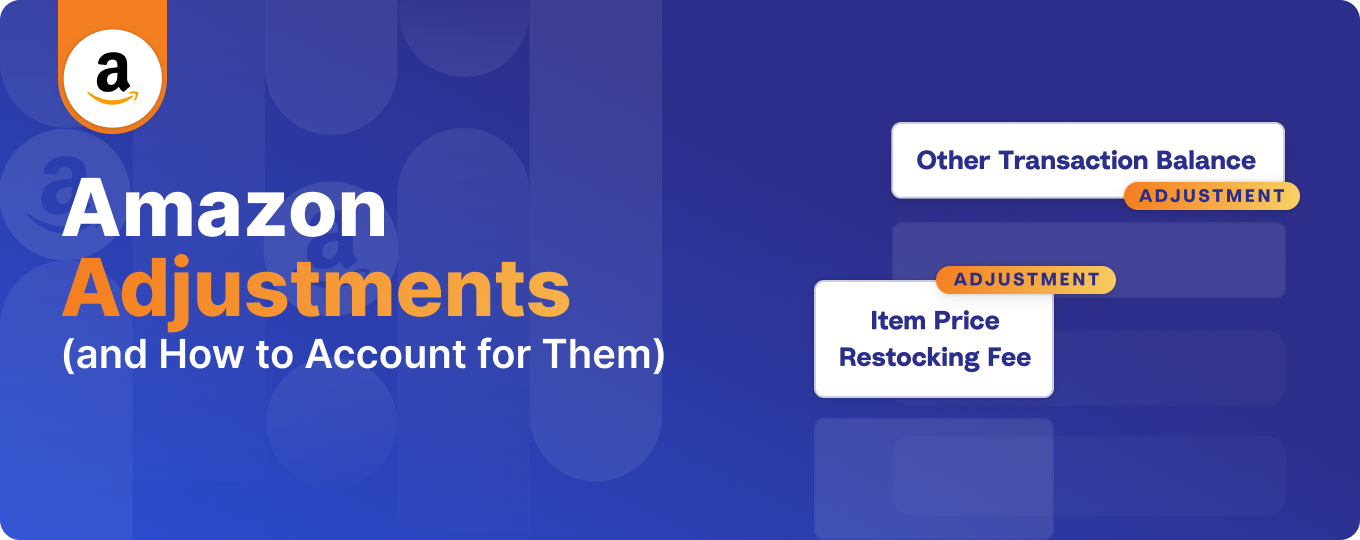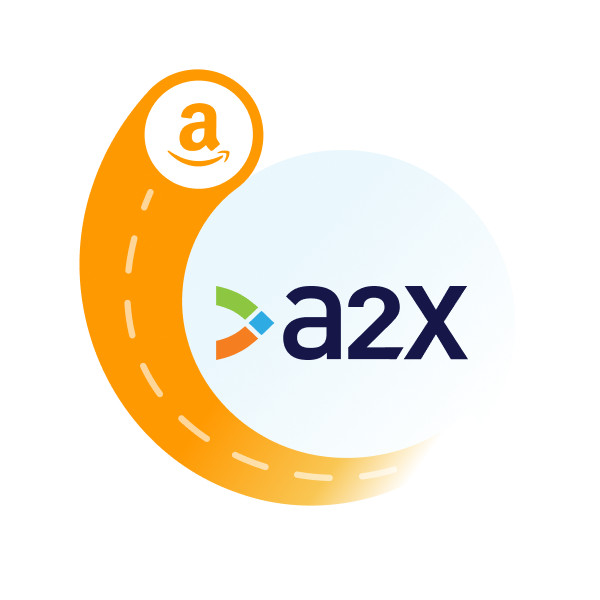Amazon Adjustments (and How to Account for Them)
Written by: Elspeth Cordray
February 28, 2025 • 7 min read

Updated on February 28, 2025.
Whether you’re a seasoned Amazon seller or are just getting started, understanding all of the fees and transactions associated with selling on Amazon can be confusing.
While knowing the definition of a specific transaction is valuable, it’s also important to take it a step further and understand how each transaction impacts your finances and how to properly account for them so that you can keep your books accurate and up-to-date. (A2X can automate this for you, and we’ll explain how below!)
Amazon adjustments can be a particularly challenging group of fees. In this guide, we’ll take a deep dive into what Amazon adjustments mean and how to account for them.
Key takeaways:
- Amazon adjustments are charges or credits applied to a seller’s account to correct inventory, pricing, or transaction discrepancies. These adjustments can be related to refunds, restocking fees, missing or extra items, and other sales corrections that impact a seller’s financial records.
- Tracking adjustments is crucial for accurate bookkeeping and financial management. Because adjustments are unpredictable and vary in amount, monitoring them helps sellers maintain accurate records, manage cash flow, and ensure proper tax reporting.
- Automating adjustment tracking with accounting tools can simplify reconciliation and save time. Integrating tools like A2X with accounting software helps categorize and track adjustments efficiently, reducing errors and improving financial accuracy.
What are Amazon adjustments?
Amazon adjustments are various charges or credits applied to a seller’s account. They help to ensure fair transactions and reflect changes in inventory or pricing scenarios.
Adjustments are often related to refunds or returned items, but could be due to reasons such as a missing item, extra items shipped, or incorrect items sent. When Amazon identifies such a discrepancy, they either debit or credit the seller’s account accordingly.
Adjustments can also relate to sales, fees and miscellaneous charges. They are any final, balancing adjustments Amazon makes to close out the books on a particular pay period.
Regularly monitoring and tracking Amazon adjustment fees can help to ensure that:
- You’re aware of any transaction discrepancies, allowing you to take corrective actions if needed.
- Your financial records accurately reflect your actual earnings and expenses, which is important for accurate tax reporting and business analysis.
Adjustments are usually situational and can vary widely and occur irregularly, making them less predictable than standard fees which are often a fixed percentage or a flat rate. The variable nature of adjustments means they can have unexpected influence on cash flow and other business finances – which makes regular bookkeeping and accounting for these fees incredibly important.
Examples of Amazon adjustments
Below are some examples of how Amazon adjustments will appear on your seller statement. Note that some adjustment line items may show up abbreviated as “adj.”
Adjustment Item Price Restocking Fee | Applied when customers return items under special circumstances, e.g., outside the return window or without original packaging. |
Other Transaction Balance Adjustment | When an inventory reimbursement is reversed. |
Liquidations Adjustments Item Price Principal | Related to the primary price of an item that's being liquidated or sold off at a discount. |
Other Transaction Misc Adjustment | Miscellaneous adjustments not categorized elsewhere. |
Adjustment Item Fees Commission / Other Transaction Commission Correction | Identified by type and reason code; usually related to inventory. |
Adjustment Item Fees Refund Commission | A refund administration fee. |
Liquidations Adjustments Item Fees Liquidations Brokerage Fee | In cases where your inventory is damaged, lost, or not suitable for liquidations, Amazon might perform a reversal of the initial payment. |
Adjustment Item Fees Shipping Chargeback | When Amazon takes care of the shipping for you on an adjusted item, and removes the fee from your account with a chargeback to balance out the transaction. |
Note: You’ll see in our Comprehensive List of Amazon Fees and Transactions that some of these transactions are also included under other categories. We’re also including them here to show that adjustments can occur across many different areas of the Amazon selling landscape.
Let’s further illustrate some of these adjustment transactions with a couple of examples showcasing when they might be applied:
- Charge – Adjustment Item Price Restocking Fee: When a customer returns an item, Amazon may apply a restocking fee as an adjustment charge to the seller’s account. This fee can vary based on the condition of the returned item and the circumstances of the return. In this scenario, an Amazon seller might be charged an Adjustment Item Price Restocking Fee.
- Credit – Other Transaction Balance Adjustment: Let’s say a customer initially fails to return an item, leading to a charge to the seller. However, if the item is later found or returned, Amazon might issue a balance adjustment credit to the seller’s account. This credit (likely an Other Transaction Balance Adjustment) compensates the seller for the previously charged amount due to the missing item, and amends the account balance.
How to use A2X to account for Amazon adjustments
Unlike some other Amazon fees and transactions, adjustment amounts can vary from settlement to settlement, and usually are not based on a standard rate (e.g., in contrast to how commission fees are charged based on defined product categories).
A2X can help you make sure that you’re capturing all adjustments and accounting for them correctly. Watch the video below to learn how A2X can help you automate your Amazon accounting.
Follow the steps below to get started. All you’ll need is your Amazon Seller Central login and your accounting software login (e.g., QuickBooks Online or Xero).
1. Sign up for A2X and connect your tools
If you haven’t already, sign up for A2X here.
Then, follow the prompts on the A2X dashboard to connect to your accounting software and then connect your Amazon store.
2. Map your Amazon transactions to your Chart of Accounts
Go to the ‘Accounts and Taxes’ page in A2X. This is where you can assign Amazon transaction types to the corresponding Chart of Accounts in your accounting software.
We recommend using A2X’s default setup for this step to save time. Answer the questionnaire and follow the prompts to automatically map all your Amazon transactions (not just adjustments!). If you need to, you can adjust any transaction mappings later.
Here’s how A2X would typically map the adjustment examples that we provided earlier. Important: We recommend working with a specialized ecommerce accountant to make sure you have mapping set up correctly for your specific business needs.
Transaction name | A2X Default Account | Account Type |
Adjustment Item Price Restocking Fee | Adjustments | Revenue |
Other Transaction Balance Adjustment | Adjustments | Expense |
Liquidations Adjustments Item Price Principal | Adjustments | Revenue |
Other Transaction Misc Adjustment | Adjustments | Expense |
Adjustment Item Fees Commission / Other Transaction Commission Correction | Amazon Seller Fees and Charges | Expense |
Adjustment Item Fees Refund Commission | Amazon Seller Fees and Charges | Expense |
Liquidations Adjustments Item Fees Liquidations Brokerage Fee | Amazon Seller Fees and Charges | Expense |
Adjustment Item Fees Shipping Chargeback | Amazon Shipping Fees | Expense |
If you sell on multiple marketplaces in different countries, you might also see a country or marketplace breakdown of your data.
3. Review transactions and post to your accounting software
Once your transaction types are mapped, go to the ‘Settlements’ page in A2X. This is where you can see a list of all your recent Amazon settlements.
Click ‘Review’ to take a look at one of your settlements. Once you’re in the settlement, look to see if the transactions that make up the settlement are mapped to the correct accounts.
If all looks good, click ‘Send to [Your Accounting Software]’.
4. Reconcile
Go to the bank feed in your accounting software.
Look for the settlement that you just sent from A2X and the corresponding Amazon deposit in your bank feed. The amounts should match up, and you’re ready to reconcile!
5. Keep up with your bookkeeping
As we mentioned, adjustments are variable and can therefore have an unpredictable impact on your business’s finances. Even if the adjustment amounts are small, it’s important to keep on top of your bookkeeping to maintain accurate financial records.
You can set up A2X’s Auto-Posting feature to automatically send settlement data to your accounting software, making bookkeeping easy, quick, and – most importantly – accurate.
Capture every Amazon adjustment with A2X
A2X makes Amazon accounting and bookkeeping easy. Sign up for a free trial and integrate A2X with QuickBooks Online or A2X with Xero today!
Learn more about Amazon seller fees and transactions and how to account for them:
- Amazon Order Revenue Transactions (and How to Account for Them)
- Amazon Delivery and Transport Fees (and How to Account for Them)
- Amazon Commission and Selling Fees (and How to Account for Them)
- Amazon Fulfillment and Storage Fees (and How to Account for Them)
- Amazon Subscription Fees (and How to Account for Them)
- Amazon Reserve Balances (and How to Account for Them)
- Amazon Reimbursements (and How to Account for Them)
Frequently Asked Questions

Integrate Amazon and your accounting software for accurate accounting
A2X auto-categorizes your Amazon sales, fees, taxes, and more into accurate summaries that make reconciliation in your general ledger a breeze.
Try A2X today
